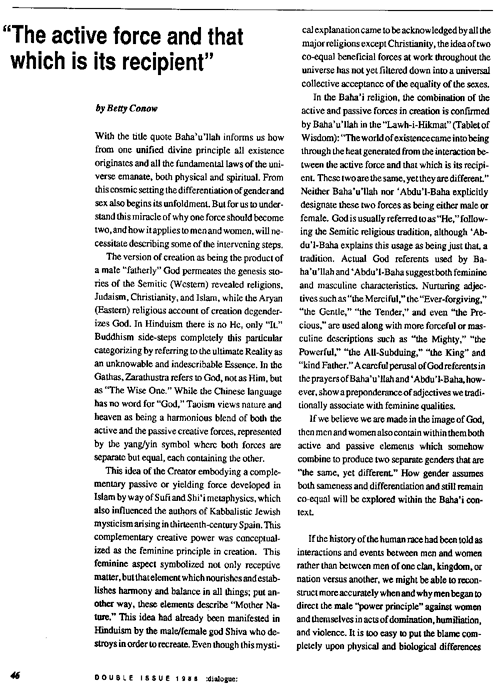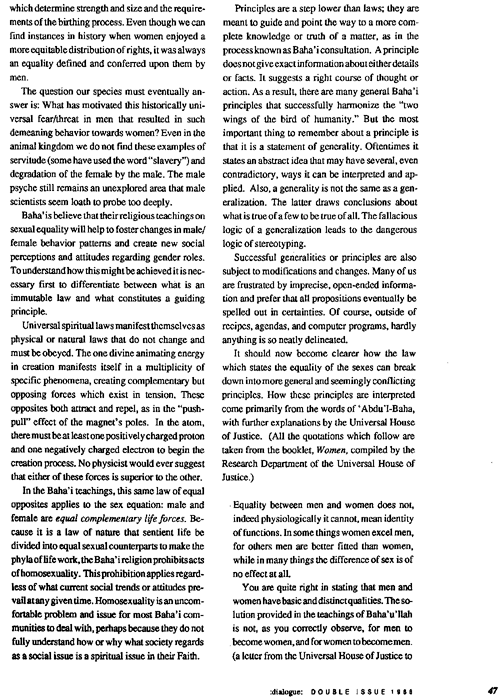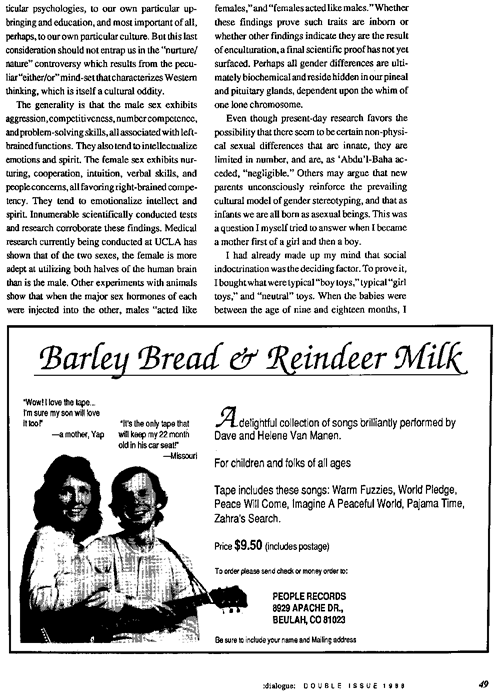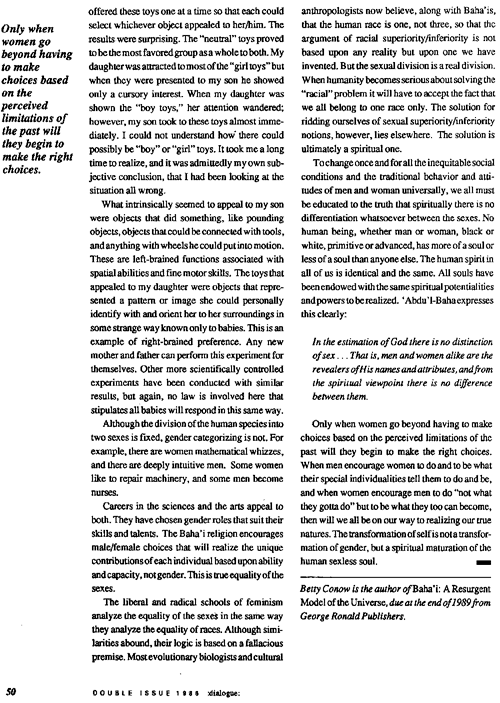
|
Abstract: Metaphysics of gender and the Lawh-i-Hikmat; universal spiritualism; social indoctrination of gender roles. Notes: See also list of dialogue articles or image scans. Please let us know if you know the source for the statement "God is usually referred to as “He,” following the Semitic religious tradition, although ‘Abdu'l-Bahá explains this usage as being just that, a tradition." |
"The active force and that which is its recipient"
by Betty Hoff Conow (published as Betty Conow)
published in dialogue, 2:2-3, pages 46-50Los Angeles: 1988
The version of creation as being the product of a male “fatherly” God permeates the genesis stories of the Semitic (Western) revealed religions, Judaism, Christianity, and Islam, while the Aryan (Eastern) religious account of creation degenderizes God. In Hinduism there is no He, only “It.” Buddhism side-steps completely this particular categorizing by referring to the ultimate Reality as an unknowable and indescribable Essence. In the Gathas, Zarathustra refers to God, not as Him, but as “The Wise One.” While the Chinese language has no word for “God,” Taoism views nature and heaven as being a harmonious blend of both the active and the passive creative forces, represented by the yang/yin symbol where both forces are separate but equal, each containing the other.
This idea of the Creator embodying a complementary passive or yielding force developed in Islam by way of Sufi and Shi’i metaphysics, which also influenced the authors of Kabbalistic Jewish mysticism arising in the thirteenth-century Spain. This complementary creative power was conceptualized as the feminine principle in creation. This feminine aspect symbolized not only receptive matter, but that element which nourishes and establishes harmony and balance in all things; put another way, these elements describe “Mother Nature.” This idea had already been manifested in Hinduism by the male/female god Shiva who destroys in order to recreate. Even though this mystical explanation came to be acknowledged by all the major religions except Christianity, the idea of two co-equal beneficial forces at work throughout the universe has not yet filtered down into a universal collective acceptance of the equality of the sexes.
In the Bahá'í religion, the combination of the active and passive forces in creation is confirmed by Bahá'u'lláh in the “Lawh-i-Hikmat” (Tablet of Wisdom): “The world of existence came into being through the heat generated from the interaction between the active force and that which is its recipient. These two are the same, yet they are different.” Neither Bahá'u'lláh nor ‘Abdu'l-Bahá explicitly designate these two forces as being either male or female. God is usually referred to as “He,” following the Semitic religious tradition, although ‘Abdu'l-Bahá explains this usage as being just that, a tradition. Actual God referents used by Bahá'u'lláh and ‘Abdu'l-Bahá suggest both feminine and masculine characteristics. Nurturing adjectives such as “the Merciful,” the “Ever-forgiving,” “the Gentle,” “the Tender,” and even “the Precious,” are used along with more forceful or masculine descriptions such as “the Mighty,” “the Powerful,” “the All-Subduing,” “the King” and “kind Father.” A careful perusal of God referents in the prayers of Bahá'u'lláh and ‘Abdu'l-Bahá, however, show a preponderance of adjectives we traditionally associate with feminine qualities.
If we believe we are made in the image of God, then men and women also contain within them both active and passive elements which somehow combine to produce two separate genders that are “the same, yet different.” How gender assumes both sameness and differentiation and still remain co-equal will be explored within the Bahá'í context.
If the history of the human race had been told as interactions and events between men and women rather than between men of one clan, kingdom, or nation versus another, we might be able to reconstruct more accurately when and why men began to direct the male “power principle” against women and themselves in acts of domination, humiliation, and violence. It is too easy to put the blame completely upon physical and biological differences which determine strength and size and the requirements of the birthing process. Even though we can find instances in history when women enjoyed a more equitable distribution of rights, it was always an equality defined and conferred upon them by men.
The question our species must eventually answer is: What has motivated this historically universal fear/threat in men that resulted in such demeaning behavior towards women? Even in the animal kingdom we do not find these examples of servitude (some have used the word “slavery”) and degradation of the female by the male. The male psyche still remains an unexplored area that male scientists seem loath to probe too deeply.
Bahá'ís believe that their religious teachings on sexual equality will help to foster changes in male/female behavior patterns and create new social perceptions and attitudes regarding gender roles. To understand how this might be achieved it is necessary first to differentiate between what is an immutable law and what constitutes a guiding principle.
Universal spiritual laws manifest themselves as physical or natural laws that do not change and must be obeyed. The one divine animating energy in creation manifests itself in a multiplicity of specific phenomena, creating complementary but opposing forces which exist in tension. These opposites both attract and repel, as in the “push-pull” effect of the magnet’s poles. In the atom, there must be at least one positively charged proton and one negatively charged electron to begin the creation process. No physicist would ever suggest that either of these forces is superior to the other.
In the Bahá'í teachings, the same law of equal opposites applies to the sex equation: male and female are equal complementary life forces. Because it is a law of nature that sentient life be divided into equal sexual counterparts to make the phyla of life work, the Bahá'í religion prohibits acts of homosexuality. This prohibition applies regardless of what current social trends or attitudes prevail at any given time. Homosexuality is an uncomfortable problem and issue for most Bahá'í communities to deal with, perhaps because they do not fully understand how or why what society regards as a social issue is a spiritual issue in their Faith.
Principles are a step lower than laws; they are meant to guide and point the way to a more complete knowledge or truth of a matter, as in the process known as Bahá'í consultation. A principle does not give exact information about either details or facts. It suggests a right course of thought or action. As a result, there are many general Bahá’í principles that successfully harmonize the “two wings of the bird of humanity.” But the most important thing to remember about a principle is that it is a statement of generality. Oftentimes it states an abstract idea that may have several, even contradictory, ways it can be interpreted and applied. Also, a generality is not the same as a generalization. The latter draws conclusions about what is true of a few to be true of all. The fallacious logic of a generalization leads to the dangerous logic of stereotyping.
Successful generalities or principles are also subject to modifications and changes. Many of us are frustrated by imprecise, open-ended information and prefer that all propositions eventually be spelled out in certainties. Of course, outside of recipes, agendas, and computer programs, hardly anything is so neatly delineated.
It should now become clearer how the law which states the equality of the sexes can break down into more general and seemingly conflicting principles. How these principles are interpreted come primarily from the words of ‘Abdu'l-Bahá, with further explanations by the Universal House of Justice. (All the quotations which follow are taken from the booklet, Women, compiled by the Research Department of the Universal House of Justice.)
Equality between men and women does not, indeed physiologically it cannot, mean identity of functions. In some things women excel men, for others men are better fitted than women, while in many things the difference of sex is of no effect at all.
You are quite right in stating that men and women have basic and distinct qualities. The solution provided in the teachings of Bahá'u'lláh is not, as you correctly observe, for men to become women, and for women to become men. (a letter from the Universal House of Justice to an individual believer)
Although ‘Abdu'l-Bahá consistently refers to the basic law of the equality of the sexes, he also makes it clear that this fact subsumes certain generalities about gender, destroying any notion we may have that equality means the same thing as identicalness. Instead, he spoke about what he called the “equality of qualifications,” that is, the sexes are equally qualified to receive all the basic rights and bonus rights offered by any given society. He further explained that although the sexes have the same inner powers, these powers are not necessarily realized in identical modes, but are expressed in different but complementary ways. ‘Abdu'l-Bahá describes how:
The world of humanity consists of two parts: male and female. Each is the complement of the other. Therefore, if one is defective, the other will necessarily be incomplete, and perfection cannot be attained.In powers and function each is the complement of the other….Women’s lack of progress and proficiency has been due to her need of equal education and opportunity…for man and woman are equally the recipients of powers and endowments from God the Creator.
It is the acknowledgment that certain non-physical characteristics separate the sexes into two distinctly operating genders that allow for the love, appreciation, and respect each may have for the other to be strengthened in sexual bonding. In the absence of these mutual physical and non-physical attractions, repulsion, hostility, and intolerance fester. This new conceptualization suggests that while the sexes are equal in the bestowal of attributes, they may be shown or expressed in different ways.
For example, ‘Abdu'l-Bahá referred to the male’s more forceful and aggressive qualities of mind and body, and of his competitiveness. He does not make any other distinctions or assign any other unique qualities to men. However, as to assigning more specialized qualities to women, he notes quite a few.
In some respects woman is superior to man. She is more tender-hearted, more receptive, her intuition is more intense….The woman has greater moral courage than the man; she has also special gifts which enable her to govern in moments of danger and crisis.
Perhaps his most thought-provoking and inspiring observation is this statement: “Hence the new age will be an age less masculine, and more permeated with the feminine ideals—or to speak more exactly, will be an age in which the masculine and feminine elements of civilization will be more properly balanced.” It is a statement worthy of memorization.
The next hurdle to overcome in fostering change in traditional attitudes and expectations regarding gender roles is how to apply the above Bahá’í guidelines to the everyday experiences of our personal lives. However, these principles will not supply us with specific details as to exactly what choices we should make on a day-to-day basis as men and women. But within these parameters we can find the guidance which applies to the general case. What is important to remember is that although there may be some basic differences in the modes men and women use to express and respond to life situations and to each other, there are no mandatory “shoulds” and “oughts” for the sexes to follow. Women differ from other women: men differ from other men, and both oftentimes resemble the other.
For any Bahá'í to suggest, for example, that all women should get married, bear children, and make the home her workplace, would be a wrong application of the Bahá'í principle of the equality of the sexes. To suggest she should exclusively seek a vocation is also a wrong application. To insist she must learn to juggle the two, is likewise wrong. There are a number of men, for example, who would dearly love to stay at home and raise the kids while the wife worked for the paycheck. Some wives marry, work, and do not want children at all. Almost any combination of the career or family controversy can be tried; the decision that one wife (or husband) makes may be the nemesis of another. These choices are all subjective choices each of us makes tailored to our own personal lives and particular psychologies, to our own particular upbringing and education, and most important of all, perhaps, to our own particular culture. But this last consideration should not entrap us in the “nurture/nature” controversy which results from the peculiar “either/or” mind-set that characterizes Western thinking, which is itself a cultural oddity.
The generality is that the male sex exhibits aggression, competiveness, number competence, and problem-solving skills, all associated with left-brain functions. They also tend to intellectualize emotions and spirit. The female sex exhibits nurturing, cooperation, intuition, verbal skills, and people concerns, all favoring right-brained competency. They tend to emotionalize intellect and spirit. Innumerable scientifically conducted tests and research corroborate these findings. Medical research currently being conducted at UCLA has shown that of the two sexes, the female is more adept at utilizing both halves of the human brain than is the male. Other experiments with animals show that when the major sex hormones of each were injected into the other, males “acted like females,” and “females acted like males.” Whether these findings prove such traits are inborn or whether other findings indicate they are the result of enculturation, a final scientific proof has not yet surfaced. Perhaps all gender differences are ultimately biochemical and reside hidden in our pineal and pituitary glands, dependent upon the whim of one lone chromosome.
Even though present-day research favors the possibility that there seem to be certain non-physical sexual differences that are innate, they are limited in number, and are, as ‘Abdu'l-Bahá acceded, “negligible.” Others may argue that new parents unconsciously reinforce the prevailing cultural model of gender stereotyping, and that as infants we are all born as asexual beings. This was a question I myself tried to answer when I became a mother first of a girl and then a boy.
I had already made up my mind that social indoctrination was the deciding factor. To prove it, I bought what were typical “boy toys,” typical “girl toys,” and “neutral” toys. When the babies were between the age of nine and eighteen months, I offered these toys one at a time so that each could select whichever object appealed to her/him. The results were surprising. The “neutral” toys proved to be the most favored groups as a whole to both. My daughter was attracted to most of the “girl toys” but when they were presented to my son he showed only a cursory interest. When my daughter was shown the “boy toys,” her attention wandered; however, my son took to these toys almost immediately. I could not understand how there could possibly be “boy” or “girl” toys. It took me a long time to realize, and it was admittedly my own subjective conclusion, that I had been looking at the situation all wrong.
What intrinsically seemed to appeal to my son were objects that did something, like pounding objects, objects that could be connected with tools, and anything with wheels he could put into motion. These are left-brained functions associated with spatial abilities and fine motor skills. The toys that appealed to my daughter were objects that represented a pattern or image she could personally identify with and orient her to her surroundings in some strange way known only to babies. This is an example of right-brained preference. Any new mother and father can perform this experiment for themselves. Other more scientifically controlled experiments have been concluded with similar results, but again, no law is involved here that stipulates all babies will respond in this same way.
Although the division of the human species into two sexes is fixed, gender categorizing is not. For example, there are women mathematical whizzes, and there are deeply intuitive men. Some women like to repair machinery, and some men become nurses.
Careers in the sciences and the arts appeal to both. They have chosen gender roles that suit their skills and talents. The Bahá'í religion encourages male/female choices that will realize the unique contributions of each individual based upon ability and capacity, not gender. This is true equality of the sexes.
The liberal and radical schools of feminism analyze the equality of the sexes in the same way they analyze the equality of races. Although similarities abound, their logic is based on a fallacious premise. Most evolutionary biologists and cultural anthropologists now believe, along with Bahá'ís, that the human race is one, not three, so that the argument of racial superiority/inferiority is not based upon any reality but upon one we have invented. But the sexual division is a real division. When humanity becomes serious about solving the “racial” problem it will have to accept the fact that we all belong to one race only. The solution for ridding ourselves of sexual superiority/inferiority notions, however, lies elsewhere.
To change once and for all the inequitable social conditions and the traditional behavior and attitudes of men and women universally, we all must be educated to the truth that spiritually there is no differentiation whatsoever between the sexes. No human being, whether man or woman, black or white, primitive or advanced, has more of a soul or less of a soul than anyone else. The human spirit in all of us is identical and the same. All souls have been endowed with the same spiritual potentialities and powers to be realized. ‘Abdu'l-Bahá expresses this clearly:
In the estimation of God there is no distinction of sex….That is, men and women alike are the revealers of His names and attributes, and from the spiritual viewpoint there is no difference between them.Only when women go beyond having to make choices based on the perceived limitations of the past will they begin to make the right choices. When men encourage women to do and to be what their special individualities tell them to do and be, and when women encourage men to do “not what they gotta do” but to be what they too can become, then will we all be on our way to realizing our true natures. The transformation of self is not a transformation of gender, but a spiritual maturation of the human sexless soul.
Betty Conow is the author of Bahá'í: A Resurgent Model of the Universe, due at the end of 1989 from George Ronald Publishers.
click for larger image
click for larger image
click for larger image
click for larger image
click for larger image
|
|




